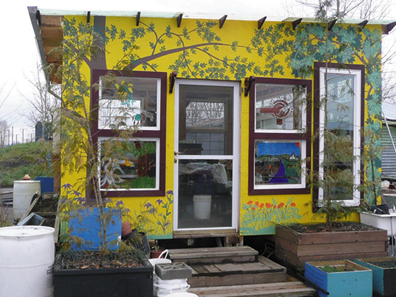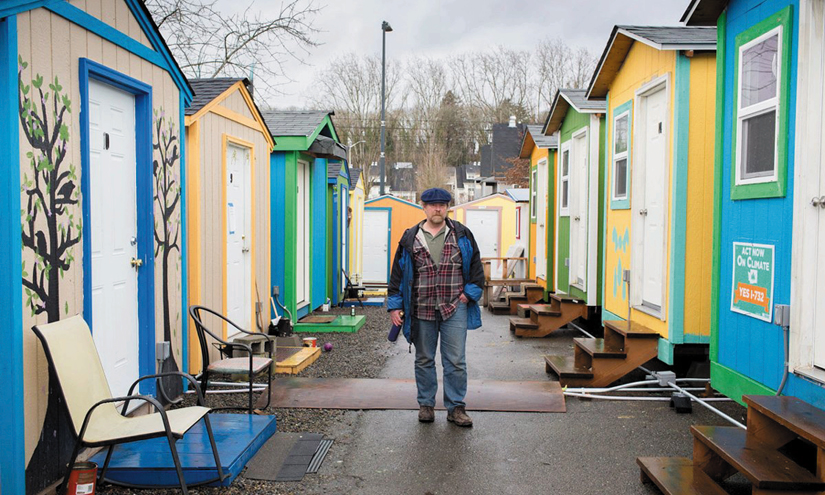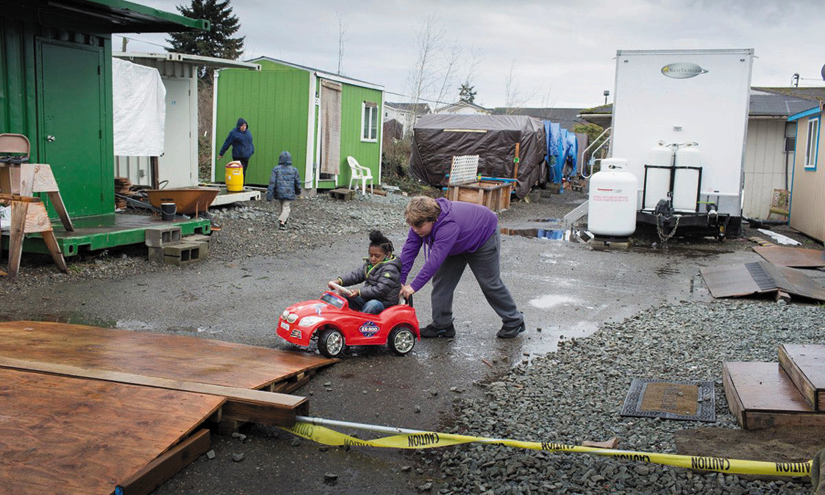
by Paul Lewis
Othello Village is on a plot of land behind a gas station, surrounded by a chain-link fence. It consists of 28 wooden huts and 12 tents that flap in a bitter Pacific wind. Residents share a shower, toilet and kitchen tent, with food stored in plastic boxes to keep out the rats.
Until recently, the cabins lacked heating or electricity, and the children who live there — currently 11 of its 67 inhabitants — had to use flashlights to read their schoolbooks.
This is how Seattle, one of the richest cities in the world, flush with cash from Amazon and Microsoft, houses some of its poorest residents.
Seattle is not alone. Wooden cabins, euphemistically referred to as “tiny houses,” are increasingly viewed as a quick and cheap solution to homelessness and, with minimal public debate, they are mushrooming across the country.
The shed-like structures have appeared in vacant lots and scrubland in at least 10 states, from Florida to New York to Utah. But the trend is most apparent in northern California and the Pacific Northwest.
Some of America’s most liberal cities have in recent years shifted from banning and clearing unauthorized homeless settlements, based in part on the argument that they were unfit for habitation, to sanctioning and even funding camps that skirt building regulations thanks to loopholes or special dispensation.
Depending on who you ask, moving homeless people into tiny houses is either a pragmatic means of rescuing them from the street or an alarming shift in urban planning that could pave the way for the creation of shantytowns.
Barbara Poppe, who coordinated federal homelessness policy for most of Barack Obama’s presidency, said she believes the development of slums is a real risk and that some of the ramshackle camps used for homeless people are “completely deplorable.”
“Why would we accept that people should be living in huts that don’t have access to water, electricity and sanitation?” she said, adding that such basic accommodation stigmatizes homeless people.
Poppe now works as a leading homelessness consultant. She was recently hired by Seattle’s mayor, Ed Murray, to review the city’s homelessness strategy. She advised against funding tiny house encampments, arguing the money would be better spent constructing permanent affordable housing. The city is going ahead with them regardless.
“I always challenge the folks on the West Coast about this,” Poppe said. “I say, ‘I don’t understand why you find it acceptable for children and infants to live like this.’” The response, Poppe added, is often a blank stare and a stock reply: “We have to do something. This is better than doing nothing.”
That’s also the view of residents of Othello Village, which opened last year. They say they are grateful for the lockable doors on their cabins, which offer more privacy than city shelters.
Shelters are also often at capacity and exclude many homeless people with rules barring couples and pets. The rules tend to be more flexible in tiny-house and tent encampments, some of which were born of previously unauthorized camps run by homeless people. Othello is self-managed, with rotations for chores such as manning the security gate.
“It’s self-organization, it’s empowering for the people involved,” said Sean Smith, a former cook who moved into his cabin a couple of months ago. “As opposed to feeling crushed under the weight of circumstance.”
Smith, who was born in Seattle and has spent much of the past three decades homeless, conceded the tiny house was rudimentary.
“It’s a wooden tent, that’s what it is, basically,” he said. “Sure, I got structure, I got the ability to lock the door. I would love to see a fully functioning village where each unit is actually a home.”
He added that someone could “get hypothermia in one of these.”
Even so, Smith and others objected last month when the nonprofit that supports the camp raised enough money to connect the huts to electricity, bringing heat and light. They felt the money would be better spent on constructing more tiny houses, because homeless people inquire about vacancies on a daily basis.
The ethics of tiny homes seem more fraught when their youngest inhabitants are taken into account.
On the other side of Seattle, on land owned by the Lutheran Church of the Good Shepherd, there is a cluster of 14 cabins. Their residents include a woman named Rhonda, who became homeless after losing her job as a restaurant manager. She said she was grateful for the shelter but was finding it a cramped place in which to bring up her five-year-old daughter, Brooklyn.
“She’s got a lot of energy,” she said. “There’s just no room. No TV. Nothing to do.” Her daughter would often rather sit in a car, she said, than spend hours inside the one-room cabin.
Sharon Lee, executive director of Seattle’s Low Income Housing Institute, which manages both settlements, stressed that the cabins are supposed to be temporary accommodation. “We don’t want tiny houses to be a dead end,” she said.
She hit upon the concept after decades navigating restrictive building codes and planning rules that made it impossible to build cheap and quick housing for homeless people. Lee was thrilled to discover “a bit of a loophole” whereby structures smaller than 120-square feet are not recognized as permanent dwellings. Tiny houses costing a mere $2,200 would be exempt from regulations governing residential buildings.
Seattle — which has declared a state of emergency over its homelessness crisis — threw its support behind the initiative, granting special permission for clusters of cabins on public and private land across the city and giving Lee $1.24 million to run various sites in 2017. By the end of the year, her organization will have 127 cabins at five locations, providing shelter to more than 310 men, women and children.
The city insists they are only a stopgap solution, and the ultimate goal is to move tiny-house residents into permanent homes. Lee said she has achieved this with 161 people.
But she conceded there was a shortage of places where people could move. Seattle’s lack of affordable housing has contributed to what Lee calls the worst homelessness crisis of her 25-year career.
Her own organization owns or manages around 2,000 units of affordable housing and is constantly building more, but it can take three to four years for any one project to come to fruition. The situation may be helped by a huge property-tax levy for low-income housing that was approved by voters last year.
In the meantime, “you have to put homeless people somewhere,” Lee said. “If the shelters can’t take them, where should they be? On the streets?”
This is not the only indication that tiny-house villages may be an enduring presence.
Ten encampments of shed-like structures for homeless people are planned for the end of 2017 in San Jose, an area where the expansion of technology giants such as Google, Apple and Facebook has contributed to an acute housing shortage and soaring rental costs. It is the most ambitious tiny-house experiment in the country.
Ray Bramson, a manager at the city’s housing department, said the aim is for every occupant of a tiny house to be moved into permanent housing within five years, a goal bolstered by the recent approval of a local ballot measure that will channel hundreds of millions of dollars into affordable homes.
In any event, the California legislation that allows San Jose to bypass building and safety rules for its tiny houses expires in 2022.
Yet Bramson conceded that “things could change” and that if the demand persists, the legislation could be renewed. “If these continue to be viable we would absolutely look into whether they could stay longer,” he said.
Andrew Heben, who helped start a tiny-house village in Oregon and has documented their rise in his book, Tent City Urbanism, said that virtually all of them began as temporary encampments that cities only reluctantly agreed to. But he said he was unaware of any that have been shut down.


“Most cities insist on the ‘temporary’ designation even though they know these will be needed into the foreseeable future,” he said.
The movement is burgeoning. In Los Angeles and Oakland, both cities that have resisted efforts for city-approved communities of tiny houses, activists have been distributing homemade varieties in unsanctioned acts of guerilla philanthropy. An artist named Gregory Kloehn has built some 50 tiny houses and distributed them to homeless people in West Oakland.
But if tiny houses for homeless people are indeed destined to become permanent features of the cityscape, some say they must meet a higher standard. There is added urgency, Heben argues, because the need for them will almost certainly increase under the Trump administration.
The Republican president has, for example, proposed cutting billions of dollars from the Department of Housing and Urban Development, which funds affordable housing.
Heben’s second village, which he begins construction on this month, will be a permanent community consisting of 250-square-feet structures — small as opposed to tiny — with en-suite bathrooms and even kitchenettes.
They will cost $60,000 per unit rather than $3,300, as at Heben’s inaugural project, yet they will still only be a third of the price of conventional affordable housing in Eugene.
These sorts of comparatively comfortable tiny homes already exist at Quixote village in Olympia, the state capital of Washington. Some view it as the gold-standard for tiny house communities. Ten of the original 30 residents who moved in three years ago have stayed, and some have signaled they want to remain for good. Quixote “is almost the pinnacle of their aspirations,” said Alan, 66, a resident for two years.
Showers and shared kitchen facilities are in a warm, permanent building, rather than the canvas tents used 60 miles away in Seattle. Every tiny house has a porch and a bathroom. As an equal proportion of the development’s total price tag, each house costs $88,000; on an individual basis they are $19,000 per unit.
Alan said that he and his ex-wife, both nurses, once had a combined income of $100,000 and a 32-foot sailboat. But their divorce tipped him into a downward spiral, and he spent more than a decade living in a homemade shack, on the streets, and in a Salvation Army shelter.
He recalled the feeling when he first moved into his tiny home in Quixote just over two years ago. “The ability to go in the cabin, close the door, lie on the bed — utter relief,” he said. “Like reaching the shore after a shipwreck.”
Alan reads for as many as 18 hours a day. “It is probably the most extreme, intense escapism,” he said. New Yorker covers decorate the walls of his cabin and books are stacked in every corner.
On the windowsill is a book that documents how shantytowns appeared across Seattle during the Great Depression. Might tiny houses for homeless people also be described as shanties?
“That’s a viewpoint taken from high above,” he said. “To the people out there on streets, living in cardboard boxes in alleyways, this represents the promised land.”
Paul Lewis wrote this story as part of “Outside in America,” the London-based Guardian’s year-long series on homelessness in the western United States. “Outside in America” focuses on people on the frontline of a devastating crisis of poverty and housing shortages. Of the 10 states with the highest rates of homelessness, seven are in the western half of the country.
*** *** *** *** *** ***
Entire Homelessness Agency Could Be Eliminated by Trump
by Alastair Gee
While much of the attention given to Donald Trump’s budget proposal has focused on dramatic cuts at the Environmental Protection Agency and the U.S. State Department, amid the many cuts in the plan is the elimination of the US Interagency Council on Homelessness.
In addition, Trump’s budget would cut billions of dollars of funding for the Department of Housing and Urban Development (HUD), which helps provide low-income housing.
Diane Yentel, president of the National Low Income Housing Coalition, warned in a statement that the proposal contained some of the deepest housing cuts since “President Reagan dramatically reduced funding in the early 1980s. Reagan’s deep spending cuts ushered in a new age of homelessness.”
In an interview, she said the reductions might result in 200,000 low-income people no longer receiving rental assistance, putting them at risk of losing the roofs over their heads. About 550,000 people were experiencing homelessness on one night in 2016.
“At a time when we have reached new heights of an affordable housing crisis, and lowest-income people are being impacted most severely, cutting resources is the wrong approach to ending homelessness,” she said.
The budget proposal is just that and will probably encounter pushback from Congress. The plan also envisions cuts at HUD of $6.2 billion, or a 13 percent fall from 2016 levels. These include programs that enable the development of affordable housing.
The cuts are explained in the proposal as reflecting a commitment to “fiscal responsibility,” and it foresees the slack being taken up by state and local governments and the private sector.
Shuttering the US Interagency Council on Homelessness, meanwhile, would free up its relatively meager budget of about $3.5 million. Yet keeping it open is “simply a prudent investment,” said Nan Roman, head of the National Alliance to End Homelessness.
“This is one of the places where I think it’s penny wise and pound foolish,” agreed Barbara Poppe, who headed the council under President Barack Obama until 2014.
The council was formed in 1987 and serves as a bridge between the various federal agencies with a stake in homelessness, such as the departments of veterans affairs or health and human services. It also connects localities both with resources and with each other as they seek to bring people off the streets.
The US Interagency Council on Homelessness “has been essential to the progress we’re seeing across the county that’s resulted in cuts to veteran homelessness by one half,” Poppe said. Homelessness in general has also decreased gradually since the recession.
While localities are taking a greater role in addressing homelessness — Los Angeles voters approved a $1.2 billion bond measure to house homeless people in the 2016 elections, for instance — they probably cannot make up for federal investment, especially not if that investment declines further.
“They decided to take this on locally because they already had a federal deficit situation,” Poppe said.
In an email to staffers after the numbers emerged, Ben Carson, the new HUD secretary, asked them to “take some comfort in knowing that starting numbers are rarely final numbers.”
Roman, of the National Alliance to End Homelessness, agrees. But she is not reassured. “It’s a very low starting point,” she said. “That’s distressing.”
